The Ramayana as a guidebook for love.
India is a land of great love stories and epic adventures and one of the greatest is the Ramayana, an epic poem on the scale of Homer’s The Odyssey, the Ramayana tells the story of Prince Rama, destined for the throne, who was unjustly exiled from his own land because of a long forgotten promise his father had made to atone for a past sin. Sita is Rama’s wife, who follows Rama into exile and later gets kidnapped by the demon Ravana. Rama searches for Sita over many years, overcoming many obstacles until he is finally reunited with her. For those of the Hindu faith, it is India’s greatest love story.
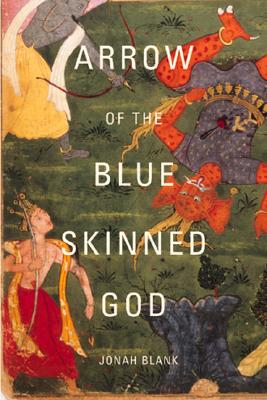 The timing seemed appropriate for me to write the second half of my post on this fascinating book I read called Arrow of the Blue Skinned God by Jonah Blank. In my first post I explored the historical perspective of this book and the Ramayana but now I want to explore the spiritual perspective, particularly as to how it relates to the concept of love. The Ramayana, which is also known as the story of Rama and Sita, has, in many ways, given me comfort during my own journey of love and sacrifice. My love story with my ex, which by comparison is far less arduous than Sita’s was with Rama, is nonetheless one which has had its share of challenges. Rama is my ex’s favorite deity, a warrior god with a high moral code is one which my ex can identify with. I can also identify with Sita’s devotion, sacrifice, stubborn will, and strength of character. Studying the Ramayana has fortified me to endure my own journey as well as provided a greater understanding of my ex’s roots,
The timing seemed appropriate for me to write the second half of my post on this fascinating book I read called Arrow of the Blue Skinned God by Jonah Blank. In my first post I explored the historical perspective of this book and the Ramayana but now I want to explore the spiritual perspective, particularly as to how it relates to the concept of love. The Ramayana, which is also known as the story of Rama and Sita, has, in many ways, given me comfort during my own journey of love and sacrifice. My love story with my ex, which by comparison is far less arduous than Sita’s was with Rama, is nonetheless one which has had its share of challenges. Rama is my ex’s favorite deity, a warrior god with a high moral code is one which my ex can identify with. I can also identify with Sita’s devotion, sacrifice, stubborn will, and strength of character. Studying the Ramayana has fortified me to endure my own journey as well as provided a greater understanding of my ex’s roots,
Most Americans, when asked which country is the most romantic, would probably answer France, Italy or perhaps Spain, but never India. However, once one learns about the story of Rama and Sita, India is a clear contender if not the hands down winner. The key to appreciating the romance of India is first understanding how the concept of love differs in India from that of the Western world.
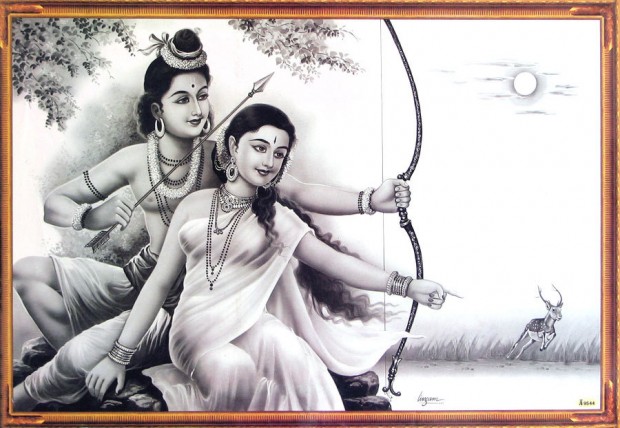
Rama and Sita
“The love celebrated in the Ramayana is a completely different breed. It comes not from the fulfillment of individual want but from their sublimation. It can exist side by side with romance,… but it does not rely on mere fleeting cupidity. It is a love that requires surrender of the self.…It is a love that makes us whole.”
 In India, love is always celebrated on an epic scale. I watched a music video from a Tamil film (in India, ‘music’ is almost exclusively generated from movies, which are required to have a minimum of 6 songs, and they are performed by the actors lip syncing to the song). The gist of this particular video, was that ‘there are seven wonders of the world but you are the eighth”. Seems corny, even childish, to us Westerners but I can speak first hand that is very close to how they really feel, especially Indians from Tamil Nadu.
In India, love is always celebrated on an epic scale. I watched a music video from a Tamil film (in India, ‘music’ is almost exclusively generated from movies, which are required to have a minimum of 6 songs, and they are performed by the actors lip syncing to the song). The gist of this particular video, was that ‘there are seven wonders of the world but you are the eighth”. Seems corny, even childish, to us Westerners but I can speak first hand that is very close to how they really feel, especially Indians from Tamil Nadu.
 Within India, the Tamils are the most romantic, as stated by the book, Arrow of the Blue Skinned God, which discusses how the Ramayana has a different ending in the culture of Tamil Nadu. To recap the story, Rama is exiled and Sita joins him in exile. Then Sita is kidnapped by the demon Ravana. Rama goes in search of her and after many struggles, finds and rescues her. After the rescue, Sita wants to embrace Rama but he expresses reticence to accept her because he is unable to believe that she was faithful to him during her years of captivity. Sita then proves her faithfulness and Rama accepts her. But then the story diverges into two versions. One version has Rama accepting Sita briefly but after pressure from his subjects, who he returns to rule, rejects Sita yet again, and Sita leaves him. She goes into hiding, bears two sons which one day return to the kingdom. Rama realizes they are his and he has made a grave error but Sita asks Mother Earth to swallow her up and she disappears, much to Rama’s regret. The Tamil version, however, is far more romantic. In this version, after his initial reticence, Rama accepts Sita and they rule together happily every after.
Within India, the Tamils are the most romantic, as stated by the book, Arrow of the Blue Skinned God, which discusses how the Ramayana has a different ending in the culture of Tamil Nadu. To recap the story, Rama is exiled and Sita joins him in exile. Then Sita is kidnapped by the demon Ravana. Rama goes in search of her and after many struggles, finds and rescues her. After the rescue, Sita wants to embrace Rama but he expresses reticence to accept her because he is unable to believe that she was faithful to him during her years of captivity. Sita then proves her faithfulness and Rama accepts her. But then the story diverges into two versions. One version has Rama accepting Sita briefly but after pressure from his subjects, who he returns to rule, rejects Sita yet again, and Sita leaves him. She goes into hiding, bears two sons which one day return to the kingdom. Rama realizes they are his and he has made a grave error but Sita asks Mother Earth to swallow her up and she disappears, much to Rama’s regret. The Tamil version, however, is far more romantic. In this version, after his initial reticence, Rama accepts Sita and they rule together happily every after.
I have mentioned several times that the Indian definition of “romance” is very different from the Western one. Most Western romance is centered around the fulfillment of desire, one which is fulfilled most often by physical contact. But in Indian love, romance is about a commitment, a duty of man to woman, a duty that endures. It is a love over time, a love that lasts forever.
“There is a love which binds a man and woman together, which lets each be the fulfillment of the other. There is a love which takes two individuals and fuses them into a single unit. There is a love which makes every man or woman the embodiment of all men and women. There is a love, which by joining human with human, also joins the human with the divine.”
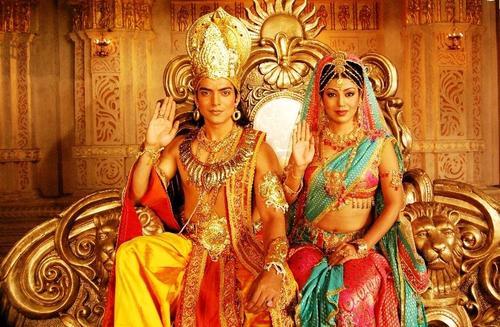
The mini series on the Ramayana, which lasted 18 months, was one of the most popular events in Indian television.
An arranged marriage, which is the norm in India still, and was the case for Rama and Sita, requires devotion and commitment because love is not always there in the beginning. Much of what India teaches about relationships is that through devotion and commitment, love will grow strong and through this strength, bonds will form and wounds healed. In Western culture where we ask “what have you done for me lately?” this may seem antiquated but it makes sense to me that if one enters into a relationship with a deep commitment then that affects not only who you choose to have a relationship with but how you manage that relationship.
“This is the love that Rama and Sita shared, this is the love that keeps India alive.”
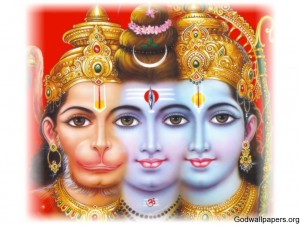
Often Sita and Rama are shown as parts of one face because of the Hindu belief that they are different faces of the same god.
I have read blogs of Indian feminists who champion the Sita of the first version of the story, the Sita that walks away from the judgmental Rama and rejects him. I might do the same if my partner didn’t trust me and pushed me away multiple times but I also know that in a relationship, it can be easy to make snap judgements, and react. I am not Indian born, nor raised in that culture, so I can not speak for the reality that is a woman in India. I can only speak for myself, for what I know, and I want to know more all the time. I can say, however, that I have learned that despite the seeming patriarchal nature of Indian culture as compared to Western culture, women in India, in many ways, have a stronger role.
“Indian women are not merely bedmates and cooks, housekeepers and mothers.…Women have ruled each of the three nations that made up India before Partition: Benazir Chutto in Pakistan, Begum Khaleda Zia in Bangladesh, and Indira Gandhi in India itself. Sri Lanka’s Sirimavo Bandaranaike, as far back as 1960, was the first female prime minister of any country in the world.”
In India love is grand, love is epic and if true, worth great sacrifice.
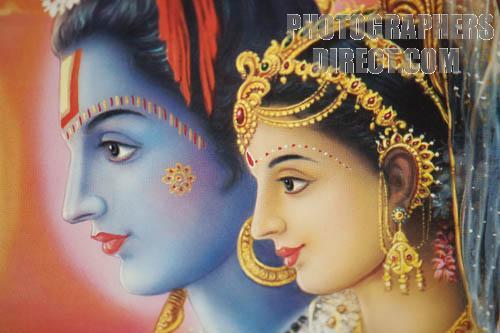
All quotes excerpted from Arrow of the Blue Skinned God.
